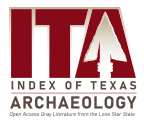Home > Research Projects and Centers > Center for Regional Heritage Research > Index of Texas Archaeology > Vol.
Agency
TxDOT
DOI
https://doi.org/10.21112/ita.2015.1.7
Abstract
The Fish Creek Slough site (41DL436) is a well stratified, multi-component, open campsite situated on an alluvial terrace on the west bank of Fish Creek in Dallas County, Texas. Discovered in 2005, the site contains an abundance of faunal material, charcoal, and burned clay within multiple, discrete stratified zones. The site was evaluated by the Texas Department of Transportation (TxDOT ) as eligible for listing in the National Register of Historic Places. Because the site was within the right-of-way for a planned road and bridge construction project, and as directed by the National Historic Preservation Act of 1966, TxDOT elected to undertake archaeological data recovery excavations to mitigate adverse effects to the site.
In October of 2010, AmaTerra Environmental, Inc. conducted archaeological data recovery excavations at the site under TxDOT contract no. 579-09-SA006. Mechanical stripping was conducted within a 6 x 20-m trench in 3–5-cm cuts down to 200 centimeters below the modern ground surface and exposed 43 burned zones, other features, and artifact concentrations. In addition to 285 cubic meters of soil removed mechanically, an additional 17.75 cubic meters was excavated within 107 hand-dug units. Collected and analyzed items included more than 8,700 faunal specimens, 43 pieces of chipped stone, and 206 fire-cracked rocks. Samples were collected for macrobotanical, magnetic susceptibility, pH, carbon, and malacology, pollen, diatom, phytolith, and ostracod assays and selected specimens of fire-cracked rock were analyzed for the presence of starches and lipids.
Thirty-nine radiocarbon dates accepted as valid helped define four discrete occupational components with the earliest occupation probably occurring as early as AD 1025, and the last occupation probably as late as AD 1865. Geoarchaeological analyses show that the stratigraphic sequence accumulated rapidly, separating and preserving the discrete occupations in good context. Analysis of the exceptionally robust and well-preserved faunal assemblage provides evidence for interpretation of change through time in social structure, site spatial occupations, and diet and subsistence. Of special note, within the occupation zones dating to the Protohistoric and Historic periods, metal cut marks on bone suggest an increased reliance on European-introduced technology.
Licensing Statement
This is a work for hire produced for the Texas Department of Transportation (TxDOT), which owns all rights, title, and interest in and to all data and other information developed for this project under its contract with the report producer. The report may be cited and brief passages from this publication may be reproduced without permission provided that credit is given to TxDOT and the firm that produced it. Permission to reprint an entire chapter, section, figures or tables must be obtained in advance from the Supervisor of the Archeological Studies Branch, Environmental Affairs Division, Texas Department of Transportation, 125 East 11th Street, Austin, Texas, 78701
Included in
American Material Culture Commons, Archaeological Anthropology Commons, Environmental Studies Commons, Other American Studies Commons, Other Arts and Humanities Commons, Other History of Art, Architecture, and Archaeology Commons, United States History Commons
Submission Location
Tell us how this article helped you.


